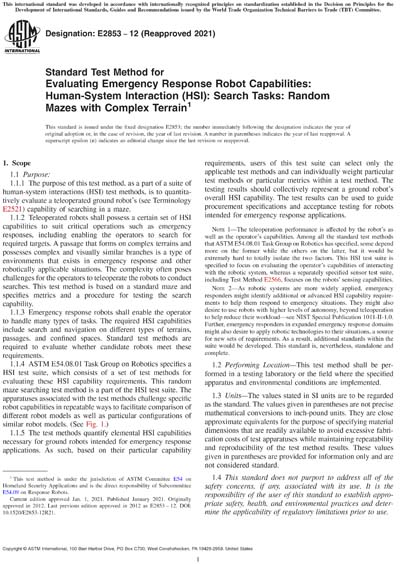Most recent
ASTM E2853-12(2021)
Standard Test Method for Evaluating Emergency Response Robot Capabilities: Human-System Interaction (HSI): Search Tasks: Random Mazes with Complex Terrain
1.1 Purpose:
1.1.1 The purpose of this test method, as a part of a suite of human-system interactions (HSI) test methods, is to quantitatively evaluate a teleoperated ground robotâ's (see Terminology E2521) capability of searching in a maze.
1.1.2 Teleoperated robots shall possess a certain set of HSI capabilities to suit critical operations such as emergency responses, including enabling the operators to search for required targets. A passage that forms on complex terrains and possesses complex and visually similar branches is a type of environments that exists in emergency response and other robotically applicable situations. The complexity often poses challenges for the operators to teleoperate the robots to conduct searches. This test method is based on a standard maze and specifies metrics and a procedure for testing the search capability.
1.1.3 Emergency response robots shall enable the operator to handle many types of tasks. The required HSI capabilities include search and navigation on different types of terrains, passages, and confined spaces. Standard test methods are required to evaluate whether candidate robots meet these requirements.
1.1.4 ASTM E54.08.01 Task Group on Robotics specifies a HSI test suite, which consists of a set of test methods for evaluating these HSI capability requirements. This random maze searching test method is a part of the HSI test suite. The apparatuses associated with the test methods challenge specific robot capabilities in repeatable ways to facilitate comparison of different robot models as well as particular configurations of similar robot models. (See Fig. 1.)
FIG. 1 HSI: Search Tasks: Random Maze Illustration

1.1.5 The test methods quantify elemental HSI capabilities necessary for ground robots intended for emergency response applications. As such, based on their particular capability requirements, users of this test suite can select only the applicable test methods and can individually weight particular test methods or particular metrics within a test method. The testing results should collectively represent a ground robotâ's overall HSI capability. The test results can be used to guide procurement specifications and acceptance testing for robots intended for emergency response applications.
Note 1: The teleoperation performance is affected by the robotâ's as well as the operatorâ's capabilities. Among all the standard test methods that ASTM E54.08.01 Task Group on Robotics has specified, some depend more on the former while the others on the latter, but it would be extremely hard to totally isolate the two factors. This HSI test suite is specified to focus on evaluating the operatorâ's capabilities of interacting with the robotic system, whereas a separately specified sensor test suite, including Test Method E2566, focuses on the robotsâ' sensing capabilities.
Note 2: As robotic systems are more widely applied, emergency responders might identify additional or advanced HSI capability requirements to help them respond to emergency situations. They might also desire to use robots with higher levels of autonomy, beyond teleoperation to help reduce their workload—see NIST Special Publication 1011-II-1.0. Further, emergency responders in expanded emergency response domains might also desire to apply robotic technologies to their situations, a source for new sets of requirements. As a result, additional standards within the suite would be developed. This standard is, nevertheless, standalone and complete.
1.2 Performing Location—This test method shall be performed in a testing laboratory or the field where the specified apparatus and environmental conditions are implemented.
1.3 Units—The values stated in SI units are to be regarded as the standard. The values given in parentheses are not precise mathematical conversions to inch-pound units. They are close approximate equivalents for the purpose of specifying material dimensions that are readily available to avoid excessive fabrication costs of test apparatuses while maintaining repeatability and reproducibility of the test method results. These values given in parentheses are provided for information only and are not considered standard.
1.4 This standard does not purport to address all of the safety concerns, if any, associated with its use. It is the responsibility of the user of this standard to establish appropriate safety, health, and environmental practices and determine the applicability of regulatory limitations prior to use.
1.5 This international standard was developed in accordance with internationally recognized principles on standardization established in the Decision on Principles for the Development of International Standards, Guides and Recommendations issued by the World Trade Organization Technical Barriers to Trade (TBT) Committee.
Content Provider
ASTM International [astm]






